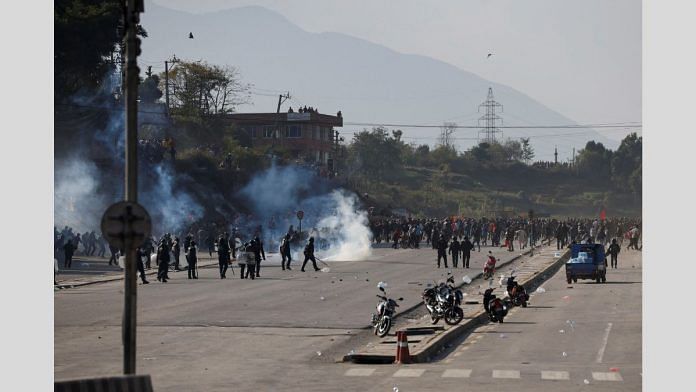New Delhi: Nepal’s capital Kathmandu saw widespread demonstrations Friday as protesters demanded the restoration of the centuries-old monarchy, and also called for it to be a “Hindu state” once again.
Nepal’s last king Gyandendra was ousted in 2006, and two years later, Nepal became a democracy and the monarchy was abolished as part of a deal that ended a decade-long Maoist insurgency.
Tens of thousands of protesters took to the streets Friday waving the national flag and calling for the return of the former king.
They were part of the “Citizens’ Campaign”, led by Durga Prasai, a member of the K.P. Oli-led Communist Party of Nepal – Unified Marxist Leninist (CPN-UML).
Nepalese officials had banned protests in the capital prior to these demonstrations.
The police used water cannons, tear gas and bamboo batons to disperse the protesters. According to Prasai, two protesters have been critically injured.
Prasai has also called for Kathmandu businessmen to support the protests by shutting their shops starting Friday.
The protesters, who support the “citizen’s movement to protect the nation, nationalism, religion, and culture”, have criticised the government of Pushpa Kamal Dahal for its failure to develop Nepal and curb corruption.
Earlier this year, a massive scandal came to the fore, with top politicians accused of falsely certifying Nepali citizens as Bhutanese refugees and sending them to the US.
The history of Nepal’s over two-century-old monarchy has been chequered with violence from the late 1700s to 2008. However, calls for the king’s ouster grew strident from 1996 when Nepali rebels pushed against his autocratic rule.
In 2001, nine members of the Nepali royal family, including King Birendra, were assassinated in a mass-shooting, which brought King Gyanendra to the throne.
Eventually, due to weeks of political agitation, he was forced to relinquish control in 2006, reinstate the Parliament, and form a new government.
Two years later, in 2008, the monarchy was abolished, Nepal was declared a Republic with the President as head of state and the king was stripped of all power. Since then, Gyanendra has been living as a private citizen with no power or state protection.
Nepal, which was a Hindu kingdom under the king till 2006, was then declared a secular state. This status was ratified by the new Constitution in 2015.
Nepal’s democratic journey has been rough as pro-monarchy calls have punctuated government tenures over widespread dissatisfaction.
In 2011, hundreds of protesters clashed with the Nepali police in Kathmandu, blocking roads that led to the Prime Minister’s residence.
This was part of a series of protests against then Prime Minister KP Oli for not handing over power to then Opposition leader Dahal, as part of a mutually-agreed upon deal.
(Edited by Tikli Basu)
Also read: India-Nepal joint military exercise begins in Uttarakhand



